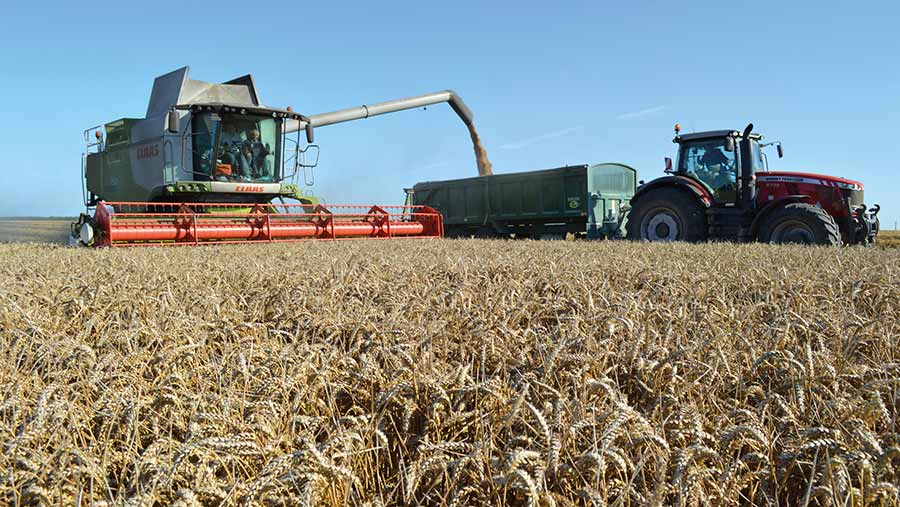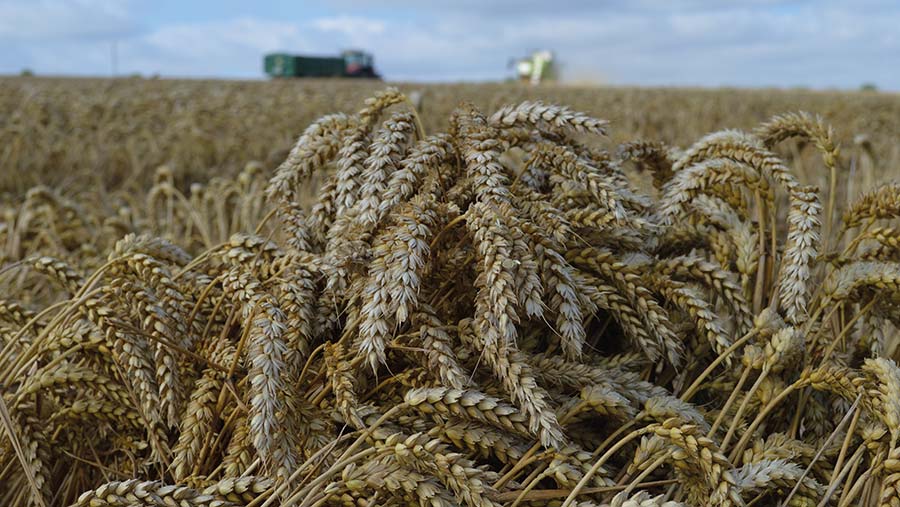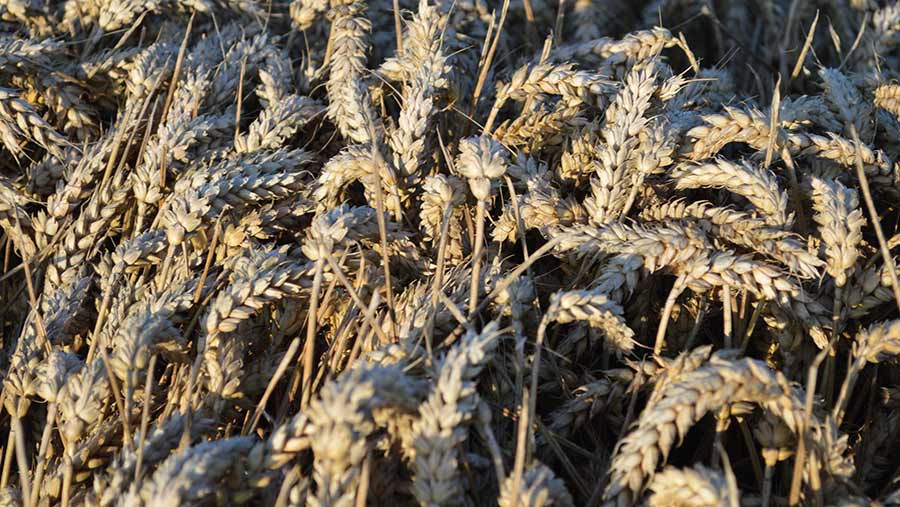How to grow a winter wheat crop yielding 15t/ha
 © MAG/David Jones
© MAG/David Jones Tim Lamyman is consistently growing wheat crops yielding 15t/ha using a high-input, high-output system across a number of varieties on his Lincolnshire Wolds farm.
His method of using high levels of nitrogen, micronutrients and fungicides has produced top yields of wheat varieties such as Theodore, Champion, Colosseum and Garibaldi.
In a season when foliar disease arrived late in Mr Lamyman’s wheat fields, fungicides were key in his three-pronged approach.
“If you drop one of these components -–nitrogen, crop nutrition or fungicides – crops will suffer. This season, crops certainly needed the fungicide element and many who cut back on fungicides saw wheat flag leaves lost early,” he says.
See also: World winter barley yield record broken in Lincolnshire
Lack of sunlight
This was not a classic high-yielding season, with sunlight levels down 20% in the spring and summer, but Mr Lamyman still grew some big crops on his 600ha largely arable farm at Worlaby, just south of Louth.
He grew four key varieties as first wheats for harvest 2021 in an intensive system, using 350kg/ha of nitrogen, a five-spray fungicide strategy and a micronutrient programme.
The nitrogen is applied in four splits and the fungicide programme includes a T4 to protect against late brown rust. Two micronutrient foliar feeds are applied in the autumn to help rooting, and five in the spring, along with fungicides, to assist with growth and development.
This high-input, high-output systems cost about £250/ha more than his standard farm approach, which calls for 220kg/ha of nitrogen and less-intensive programmes of fungicides and micronutrients.
The intensive approach has seen him take the top yield title in the Yield Enhancement Network (YEN) competition, organised by crop consultant Adas, for five out of the eight years it has been run. He also holds the current winter barley yield world record, and he has been the world record holder for wheat and oilseed rape yields in the past.
As part of his drive for consistency and search for wheat varieties to fit into a second, third and fourth cereal spot, he has assessed a number of varieties and highlights four from last season.
Theodore
This feed wheat with excellent septoria resistance is a shy tillering variety, so requires a high seed rate and selective drilling window.
Mr Lamyman grew 13ha of this DSV-bred variety for harvest 2021, and it gave a yield of 15t/ha with a specific weight of 74.5kg/hl. The crop was drilled on 30 September at a relatively high seed rate of 250kg/ha.
He says this was one of the easiest wheat varieties to manage because of its good disease resistance, especially to septoria. It also does not seem to suffer too badly from drought in the spring.

Theodore wheat © MAG/David Jones
“Because of its good disease resistance, we felt we could push the yield on the right type of land. I think it is a variety that may be right for the early drilling slot,” he says.
The crop was harvested on 18 August, giving an ear population of 770 heads/sq m.
The variety has the advantage of good standing power, early maturity and a good disease resistance package, but it must be drilled between 25 September and the last week of October, he says.
He is looking for a second wheat to replace his old favourite, Marston, so Theodore looks like a good, solid bet, and he plans to increase his area up to 50ha this autumn.
Champion
This is another feed wheat variety from DSV with great yield potential, which yielded 14.9t/ha this summer, despite using a much lower seed rate because of the shortage of available seed.
The variety, which was picked out by Mr Lamyman’s son, Rob, threw up a lot of grains per ear, and has very good septoria resistance for a Group 4 feed wheat.
“We believe the variety has the potential to be pushed hard with the right sunlight and water, but this season we were short of sunlight,” he says.
The variety was sown on 13 September at 75kg/ha, giving only 81 plants/sq m, but produced nearly 15t/ha, with a good specific weight of 76kg/hl. Each large wheat ear delivered 65-70 grains, and was harvested on the same day as Theodore.
Mr Lamyman says this tall variety has a very wide drilling window, from mid-September to the end of December, although he warns against ultra-early drilling due to its straw height. “We think it shows good grain quality and seed size, and it look like a very consistent variety, with an incredibly wide drilling window.”
He plans to increase his area of the variety from 9ha to 40ha this autumn, as he feels the variety has big potential at the right seed rate. This autumn he will use a higher seed rate of 125kg/ha.
He will assess whether Champion or Theodore can take over the second wheat position from Marston, which is the most consistent wheat he has ever grown and produced yields of 9.5-13.9t/ha in the second, third and fourth wheat slot at harvest 2021.
Colosseum
This feed variety from breeder KWS is another early driller like Theodore. It produced 15.6t/ha, but at a disappointingly low specific weight of 71.5kg/hl.
It delivered a bold sample, but without the hoped-for decent specific weight. If the specific weight had been 78kg/hl, this could have challenged the New Zealand-held wheat world record of 17.4t/ha, set in February 2020.
The variety was drilled on 14 September at a seed rate of 225kg/ha due to its shy tillering. It could fill the early drilling slot, as it is a slow to medium starter at growing away.

Colosseum wheat © MAG/David Jones
It again produced big heads of 55-60 grains/ear and had a relatively small flag leaf, which allows light to get to leaves two and three. “It is the most consistent of the early-drillers, and has good standing power and generally good disease resistance,” Mr Lamyman says.
It does have slightly low resistance to eyespot, so he included the azole prochloraz at T0 and prothioconazole at T1.
Garibaldi
This wheat variety from independent breeder Bill Angus is an incredibly strong tillerer, so is well suited to late drilling.
It produced a yield of 14.7t/ha this summer at a good specific weight of 78kg/hl after being drilled on 30 September at a seed rate of 200kg/ha.
A second field drilled later in November yielded 12.9t/ha at 79kg/hl. It shows similar tillering ability to Champion, throwing up bold heads.
“I see this variety as a fantastic late-driller with an incredible tillering capability, giving good grain size and an even crop,” he says.
This season, Mr Lamyman will be growing another 20ha of the variety, trying it out as a second wheat drilled from late October to the first two weeks of November at a relatively low seed rate of 150kg/ha.
This tall variety could prove a very useful late-driller from mid-October to end-December, and could be good in a delayed-drilling situation to control blackgrass.
This season
The only new variety Mr Lamyman is trying this season is Typhoon, from breeder Limagrain, which has a good tillering ability.

